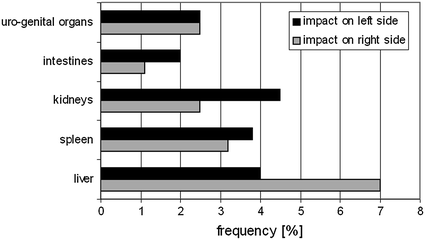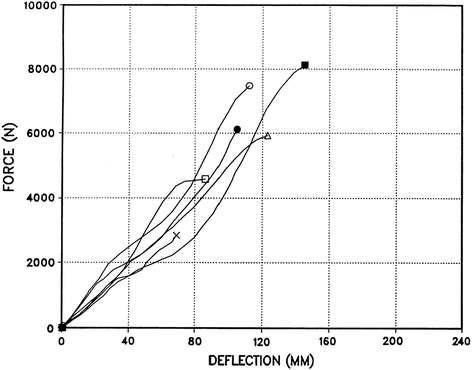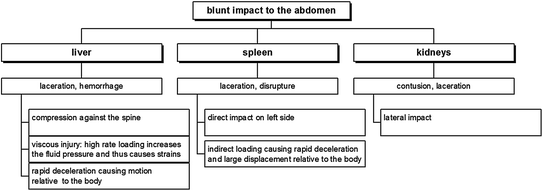In summary from an anatomical point of view, possible injury mechanisms seem to be dependent on the complex structure of the abdomen together with physical properties like the density, structure and the material within the organs.
6.2 Injury Mechanisms
Due to the complex structure of the abdomen, there are many factors influencing the location, likeliness and severity of a blunt impact. First of all, anatomy suggests that the position of an organ contributes to its injury risk. Organs that are located anterior of the vertebral column are, in case of a frontal impact, more likely to be compressed against the spine than those lying laterally. Additionally, the upper abdomen is in part covered by the lower rib cage, which also has a protective effect in frontal impact. Obviously, the non-symmetric organisation of the abdominal organs accounts for different injury risk depending on the impact direction. If the abdomen is struck from the right side, liver injury is more probable than if struck from the left (Fig. 6.2). As the lung, the liver can experience a central rupture where the tissue around the damaged part is not altered.


Fig. 6.2
Frequency of AIS >3 abdominal injury for different organs due to lateral impact on the right or left side, respectively (adapted from Rouhana et al. 1985)
Examples of possible abdominal injuries and their classification according to the Abbreviated Injury Scale (AIS) are given in Table 6.1.
AIS code | Description |
|---|---|
1 | Skin, muscle: contusion (hematoma) |
2 | Spleen or liver contusion (<50 % surface area) |
3 | Major kidney contusion spleen: rupture |
4 | Abdominal aorta: minor laceration kidney/liver: rupture |
5 | Kidney: total destruction of organ and its vascular system |
6 | Hepatic avulsion (total separation of all vascular attachments) |
In automotive crashes, the vehicle interior offers several contact areas that strongly influence the injury outcome when hit. Possible contact points include the steering assembly, the side door, the arm rest, the dashboard and the glove compartment, whereas unbelted occupants are, of course, at higher risk to contact such structures than belted ones.
Also the structure of the organs themselves is important in terms of abdominal injury. Solid organs were found to be injured more often than hollow organs. Furthermore, the pathological state of an organ can have a marked influence on the injury tolerance due to changes of the material properties (e.g. stiffness). Among other medical conditions, previous surgery resulting in adhesions inside the abdominal cavity is also suspected to predispose the subject to injury. The age of a patient was shown to affect the injury outcome in blunt trauma, with children and the elderly being at higher risk. Particularly for children anatomical reasons have to be considered as, for example, the abdominal region is proportionally larger than in an adult, the liver is less protected by the rib cage and thus at higher risk. However, analysing cases of children that sustained abdominal injury due to seat belt compression it was observed that first of all incorrect and/or inappropriate use of the restraint system lead to the injury (e.g. Arbogast et al. 2007).
6.3 Testing the Biomechanical Response
In the same way as for other regions of the human body, the biomechanical response of the abdomen is addressed in experimental studies utilising cadavers or animals. Several studies used impactors that completely covered the abdomen (in front as well as in lateral impact). However, the overall response curves obtained do not account for the non-homogenous nature of the abdomen. The location of impact (e.g. left side or right side) and the posture of the object during impact play important roles.
The test conditions chosen do, of course, also influence the outcome of the experiments. Analysing the biomechanical response of the abdomen, the so-called “fixed back” condition (in contrast to the “free back” condition) is often used. By fixing the back of the object during impact the influence of the spine is eliminated.
In terms of experimental procedure it turned out to be quite difficult to accurately determine the deflection of the abdomen. Mostly high speed videos were evaluated, sometimes determining the intrusion with respect to a fixed point (e.g. the spine) or measuring the compression relative to the other side of the object. Due to the poor quality of most of these videos, many studies were not able to determine the deflection and therefore reported the force history only. Others, as pointed out by Rouhana (2002), presented results that are not reliable.
Today, force-deflection curves obtained from cadaver tests are available for the lower abdomen in frontal impact (Cavanaugh et al. 1986; Nusholtz et al. 1988) (Fig. 6.3). Also Hardy et al. (2001) and Foster et al. (2006) reported response data from cadaver testing for different test conditions including loading due to airbag and seat belt.


Fig. 6.3
Force-deflection characteristics for the lower abdomen obtained in frontal impact tests using a rigid impactor (adapted from Nusholtz et al. 1988)
For the upper abdomen in frontal impact, it is suggested to use the same data as for the lower abdomen until better data is available (Rouhana 2002). With respect to lateral impact, several cadaveric studies were presented performing sled tests, pendulum tests and drop tests. Drop tests especially addressed the impact on an arm rest, dropping the cadaver from a certain height on the arm rest (e.g. Walfisch et al. 1980). Force–time curves instead of force-deflection curves were presented (see above).
For blunt impact on kidneys, Schmitt and Snedeker (2006), Schmitt et al. (2006) carried out pendulum tests on human as well as porcine kidneys. It was shown that the kidney tissue failure is a predominately energy driven phenomenon. The visco-elastic material properties were described and force–deformation characteristics are provided.
In Fig. 6.4 possible injury mechanisms and the resulting injury are presented for the three organs injured most often.


Fig. 6.4
Possible injuries and injury mechanisms for different abdominal organs
6.4 Injury Tolerance
Several experimental studies were performed to find ways to quantify the biomechanical response of the abdomen to impact and consequently to develop suitable injury criteria. The strength of various mechanical parameters as predictors of abdominal injury was investigated. Although various possibilities were addressed, not many conclusions in terms of tolerance thresholds could be drawn. This, again, reflects the complex nature of the abdomen and the difficulties associated with the performance of adequate experiments. Consequently, further basic research is needed to elucidate the injury mechanism and appropriate injury tolerance levels. This paragraph summarises the most important attempts to quantify predictors for abdominal injury.

Full access? Get Clinical Tree








